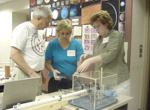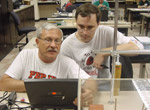
Reporters may contact: Ellen Mayou
emayou@mail.smu.edu
SMU News & Information
(214) 768-7659

June 8, 2001
SUMMER PROGRAM AT SMU GIVES HIGH SCHOOL SCIENCE TEACHERS IDEAS ON HOW TO TEACH STUDENTS ABOUT MODERN PHYSICS
Click on the photos below to view or download high-resolution .jpg versions.
DALLAS (SMU) -- In the basement of a college science building, a group of high school teachers are laughing and shouting as they shoot jawbreakers through pieces of plastic tube at a target encased in plexiglass.
"Do not eat any of the protons," instructor Darren Carollo admonishes the teachers.
 While
this looks like fun and games, there is a serious side to this experiment.
It is helping these high school science teachers learn how they can help
their students understand complicated concepts such as particle physics.
While
this looks like fun and games, there is a serious side to this experiment.
It is helping these high school science teachers learn how they can help
their students understand complicated concepts such as particle physics.
"When you are talking about muons, leptons and protons the average student can't understand you," Carollo said. "But when you take a jawbreaker and run it through a tube at 200 to 300 miles per hour and they can see it explode against a rock and fragment, they can understand that. And that gets them interested in high-energy physics."
This summer, 18 teachers from Dallas-area high schools are on the Southern Methodist University campus participating in a program called QuarkNet that is designed to help them and their students learn about the latest discoveries in physics. The program is sponsored by the National Science Foundation, the Department of Energy and two of the world's leading high energy physics research centers -- Fermilab in Illinois and CERN in Switzerland.
Carollo, who teaches biology and physics at Lincoln High School in south Dallas, said he decided to apply for the QuarkNet program after he was charged with finding an experiment that would help high school students understand particle physics. He was accepted for the program, and last summer he spent eight weeks working with SMU physics professors. He also was given the opportunity to visit CERN in Switzerland.
This summer, Corollo is one of three local high school teachers who are working with SMU physics professors to extend the QuarkNet program to other area high school teachers. The 18 participating teachers are at SMU for a two-week workshop that includes a variety of lectures and hands-on labs.
 Carollo
developed the jawbreaker experiment as a way for teachers to show students
what real physicists study with a linear accelerator. As compressed air
shoots the jawbreakers into the box, a computer wired to the target enables
them to measure velocity, acceleration, force, mass, momentum and the
number of particles created when the jawbreakers explode.
Carollo
developed the jawbreaker experiment as a way for teachers to show students
what real physicists study with a linear accelerator. As compressed air
shoots the jawbreakers into the box, a computer wired to the target enables
them to measure velocity, acceleration, force, mass, momentum and the
number of particles created when the jawbreakers explode.
Other labs developed for this month's QuarkNet program include one in which the teachers will build a cosmic ray telescope, another in which they will build a cloud chamber to measure radioactive decay and a third in which they will analyze some real data from Fermilab.
Teachers participating in the QuarkNet program this summer will continue to meet throughout this year to share ideas and will return to SMU for another one-week workshop next summer.
SMU physics professors Fred Olness and Ryszard Stroynowski applied to offer the QuarkNet program at SMU so that they could share their research with high school teachers and give these teachers some knowledge they could take back to their classrooms. Both professors are involved with CERN and the construction of the world's largest particle accelerator underneath the ground in Geneva, Switzerland.
"If teachers don't know what we're doing, they can't convey that to students," Olness said. "When students study physics in high school, most of it is old concepts from the 1600s to the 1900s. It is not modern physics."
Norman Thompson, a physics teacher from Crandall, Texas, who is participating in QuarkNet, said he is enjoying this opportunity to learn about cutting-edge topics in physics first-hand.
"When you talk to people who have built the accelerators it gives you a lot better perspective on how it's all done rather than just reading it in a book," he said.
TEACHERS PARTICIPATING IN QUARKNET AT SMU
Cedar Hill
Dirk William Horst, Cedar Hill High School
Crandall
Norman Thompson, Crandall High School
Dallas
Shamsia Ali, Carter High School
Courtney Barber, Woodrow Wilson High School
Darren Carollo, Lincoln High School
Larry Grise, Metropolitan Christian School
Sylvia Pickrell, Skyline High School
Warren Ruckett, Science and Engineering Magnet High School
Pat Spikes, Middle College High School
Farmersville
Jerry Shaffer, Farmersville High School
Garland
Richard Lines Jr., Garland High School
Danielle Reynolds, South Garland H.S.
Irving
Karan Scaife, Irving High School
Robert Brown, MacArthur High School
Muleshoe
Jack Willis, Muleshoe High School
Plano
Kris Whelan, Plano East Senior High School
Richardson
Ken Taylor, Lake Highlands High School
Sandra Lyman, L.V. Berkner High School
Note to editors: These teachers will be at SMU through June 15. Afternoons from 1-3 p.m. are the best time to get pictures.